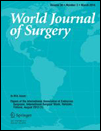Is Vocal Cord Asymmetry Seen on Transcutaneous Laryngeal Ultrasonography a Significant Predictor of Voice Quality Changes After Thyroidectomy?
Abstract
Background
Vocal cord asymmetry (VCA) on laryngoscopic examination (LE) may suggest voice impairment after thyroidectomy, but LE may cause patient discomfort. We aimed to correlate the presence of postoperative VCA assessed by noninvasive transcutaneous laryngeal ultrasonography (TLUSG) with voice quality changes after thyroidectomy.
Methods
A total of 169 patients scheduled for thyroidectomy completed two validated voice symptoms questionnaires—the GRBAS (grade, roughness, breathiness, asthenia, strain) scale and the voice impairment score (VIS)—and underwent TLUSG and LE at 1 day before and 7–10 days after thyroidectomy. Postoperative VCA was apparent in 51 patients on TLUSG (group I), whereas there was no VCA in the other 118 patients (group II, controls). The GRBAS scale and VIS results were compared between the groups.
Results
Before operation, the two groups had comparable preoperative GRBAS and VIS status. After operation, the “grade” and “roughness” components on the GRBAS scale were significantly worse in group I than in group II: 0.24 versus 0.07 (p = 0.016) and 0.33 versus 0.14 (p = 0.022), respectively. “Grade” and “roughness” in the GRBAS scale significantly worsened after the operation in group I: from 0.04 to 0.24 (p = 0.008) and from 0.02 to 0.33 (p = 0.001), respectively. They did not change in group II. Also, the overall VIS was significantly worse after thyroidectomy in group I: 4.97 versus 12.97 (p < 0.001).
Conclusions
VCA seen on TLUSG significantly correlated with “grade” and “roughness” components on the GRBAS scale and the overall VIS. Thus, VCA might be used as a surrogate of postoperative voice changes.




